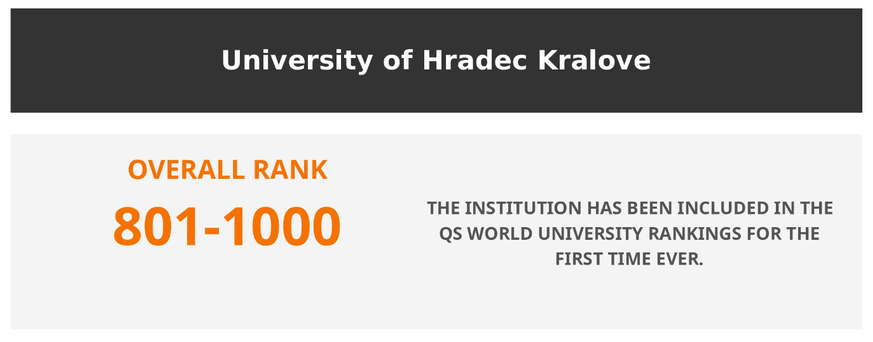The University of Hradec Králové is on the rise in another prestigious international ranking!

For the first time in history, UHK was ranked in the QS World University Rankings. Since 2015, we have been included in the partial ranking of this institution, which evaluates a group of universities across selected parts of Europe and Asia. At Emerging Europe and Central Asia, we are currently ranked 176th.
The Rector of UHK, Kamil Kuča, comments on the great success: "The efforts and diligence of all those who are part of our university were finally appreciated by the major QS rankings, we made it into the first 1000 ranked, on the shared 801-1000th place out of a total of 1300 evaluated universities. I am very pleased that together we are finally able to draw attention to our legitimate global ambitions in the world, despite our regional character. We prove once again that we are going in the right direction. I am very proud of the scientific research and creative activity, thanks to which we are increasingly attractive even in international comparison. "

The comprehensive criteria of the current QS WUR Rankings focus on academic reputation, quality of graduates, the ratio of academics to students, citations in scientific journals, and internationalization. In addition to the high number of international students, the number and quality of study programs taught in English, and the reputation of UHK in the academic environment, we are also rated very highly in terms of the number of students per academic.
"Finally, the homely environment at the university, manifested in the proximity and accessibility of academics to students, is one of the qualities that we have long maintained and supported," adds Rector Kuča.
The QS WUR methodology consists of five metrics that give an objective picture of an institution.
- academic reputation generates forty percent of the ranking. It is one of the most extensive surveys where academics may express their opinions,
- employer reputation measures how an institution prepares a student for the future employment market,
- faculty/student ratio proves that it is the most important metric for students themselves. It shows how they perceive teaching. It also measures how an institution can provide students with lectures and recognizes that a high number of faculty members per student will reduce the teaching burden on each academic,
- citation per faculty meaning research output. This metric collects the total number of citations received by all publications produced by an institution across a five-year period by the faculty members. There is a six-year citation window to take in mind. It takes time for research to be effectively broadcasted,
- international faculty ratio/international student ratio measures how an institution is able to attract foreigners from around the world. It creates a multinational environment from which students and staff may benefit.
With a better understanding of each metric, it is evident that this comprehensive evaluation reflects reality and provides feedback to all involved. Based on this information, the final score is determined.

